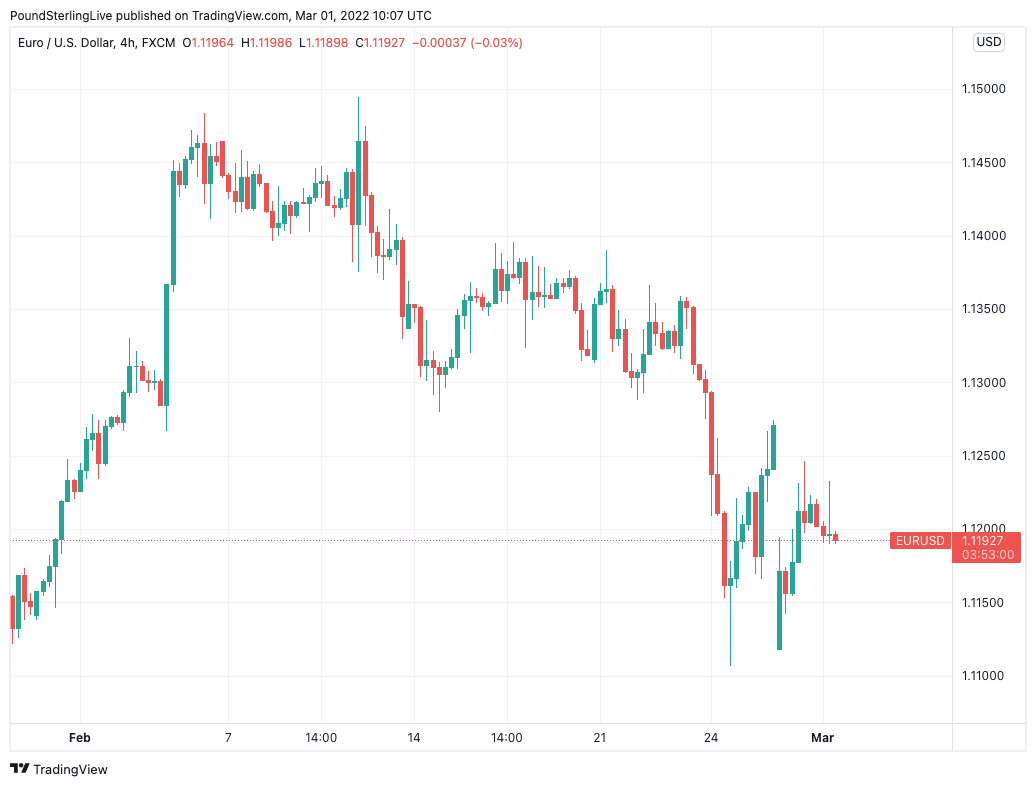Euro / Dollar Increasingly at Risk of a Test of 1.10: Analysts
- Written by: Gary Howes
-
"We view the single currency as vulnerable. A break of the recent low close to the 1.11 level would likely focus attention on 1.10" - Rabobank.

Image © Adobe Images
War in Ukraine, rising energy prices and a paring back of European Central Bank rate hike expectations are all weighing on the Euro say analysts.
The Euro was one of the currency market's top performers until geopolitical tensions blew up when Russia invaded Ukraine on February 24 and now strategists are eyeing an extension of weakness to fresh multi-year lows.
As of the first of March the market was expecting 27 basis points of European Central Bank rate hikes to be delivered by year-end, down on the 55 basis points of hikes priced in on February 07 when markets had digested the ECB's February 03 policy shift.
(The ECB said on February 03 inflation was a concern for all members of the Governing Council and that they could therefore no longer rule out a 2022 rate hike, the Euro rose sharply in response.)
The drop in ECB rate hike expectation pricing is linked directly to Russia's invasion of Ukraine which has brought about tremendous political shifts in the EU and pushed up the cost of energy.
"Should oil and gas prices stay at elevated levels throughout the rest of the year, inflation rates well in excess of 6% could be on the cards for H2 22," says Aila Mihr, Senior Euro Area Analyst at Danske Bank.
Danske bank now also sees downside risks to their 2022 euro area GDP forecast of 4.0% of 0.4-0.5pp, mainly through the adverse hit to consumers from continued high inflation.
"Falling equity prices and rising commodity prices will have real economic implications. Economies could also suffer from reduced trade as well as from rising uncertainty that could dampen households’ and firms’ willingness to consume and invest," say currency analysts at Swedbank in a recently published research briefing.
Above: EUR/USD trade February-March 2022.
- EUR/USD reference rates at publication:
Spot: 1.1190 - High street bank rates (indicative band): 1.0799-1.0878
- Payment specialist rates (indicative band): 1.1090-1.1135
- Find out more about market-beating rates and service, here
- Set up an exchange rate alert, here
The European Central Bank's chief economist Philip Lane told fellow policymakers in an initial assessment that the Ukraine conflict may reduce the Eurozone's economic output by 0.3%-0.4% this year, four people close to the matter told Reuters.
This was the "middle scenario" presented by Lane at a Governing Council meeting in Paris on Thursday
The estimates as "back-of-the-envelope" calculations, another said they were "very preliminary" and a third said they were mostly derived from commodities prices.
Higher inflation and slowing growth risks creating a stagflationary environment which is less consistent with 'hawkish' central bank hiking than an inflationary environment stoked by a strengthening economy and rising wages.
"In view of the risks to gas and oil supply to Germany, the EUR could find itself stifled by a new wave of growth risks and potentially by increased concerns about stagflation," says Jane Foley, Senior FX Strategist at Rabobank.
The Euro had risen in early February in line with the reprisal by rates markets for ECB interest rate hikes, but these gains have since been reversed and the Euro to Dollar exchange rate trades back at 1.1193 at the time of writing.
"We view the single currency as vulnerable. A break of the recent low close to the 1.11 level would likely focus attention on 1.10," says Foley.
Near-term, risk sentiment will also continue to influence Dollar and Euro movements, with the former benefiting when tensions relating to Russia and Ukraine spike.
{wbamp-hide start}
{wbamp-hide end}{wbamp-show start}{wbamp-show end}
"The most important short-term risk for EUR is the Ukraine-Russia crisis. The risks are asymmetric, with escalation more negative for EUR," says John Shin, an analyst at Bank of America. "We continue to forecast EURUSD at 1.10 by the year-end."
Russia continues its offensive on Ukraine despite the imposition of severe sanctions from a coalition of nations that even includes countries that are traditionally resolutely neutral in times of conflict, such as Switzerland and Singapore.
Disruptions to trade and fears for Eurozone economic growth linked to the crisis are an obvious near-term conduit to Euro weakness say analysts.
"The eurozone will likely be hurt more than the US by the current Russia/Ukraine crisis, given its implications on growth, inflation, and monetary-policy strategies," says Roberto Mialich, FX Strategist at UniCredit.
"The negative effects on the overall global outlook will be limited, while recognising that there’s a risk of a bigger impact on many EU countries," says Swedbank.






